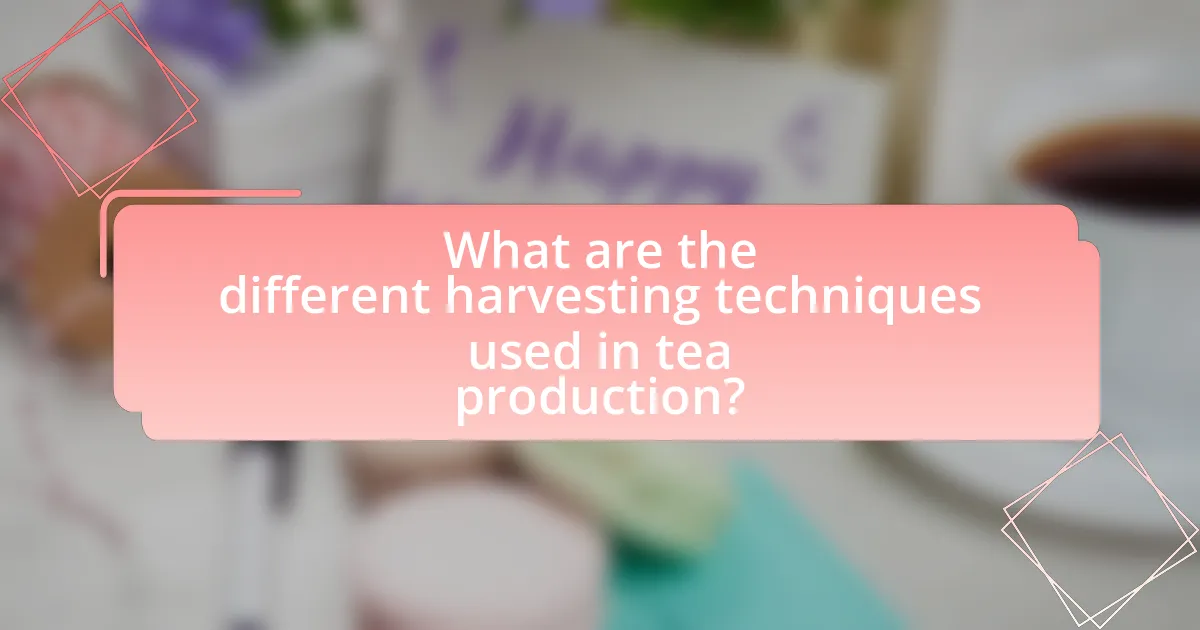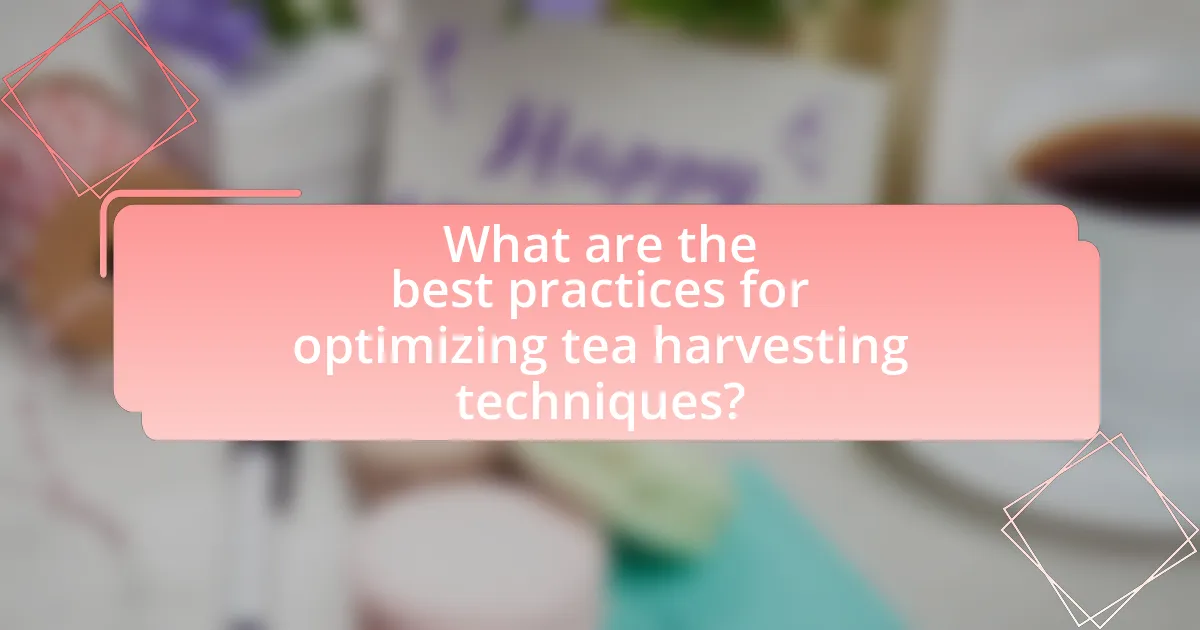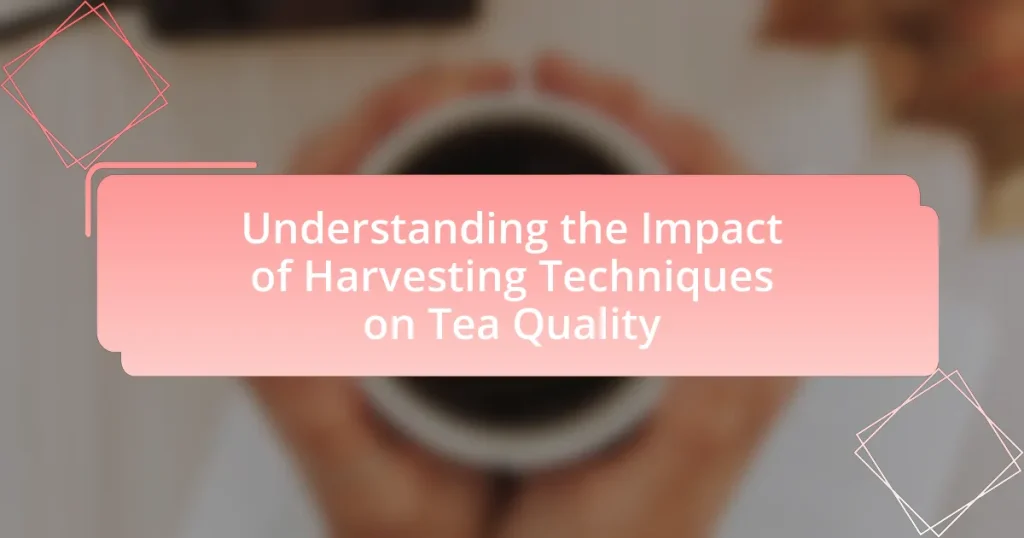The article focuses on the impact of harvesting techniques on tea quality, highlighting three primary methods: hand plucking, mechanical harvesting, and selective harvesting. It examines the differences between traditional and modern techniques, emphasizing how hand-picking enhances flavor and quality by allowing for the selection of the finest leaves. The article also discusses the influence of factors such as tea plant type, climate, and timing on harvesting practices, and how these elements affect the chemical composition, flavor profile, and overall quality of tea. Additionally, it outlines best practices for optimizing tea harvesting and the consequences of improper techniques.

What are the different harvesting techniques used in tea production?
The different harvesting techniques used in tea production include hand plucking, mechanical harvesting, and selective harvesting. Hand plucking is the traditional method where skilled workers selectively pick the top two leaves and a bud, ensuring high quality and flavor. Mechanical harvesting involves the use of machines to collect leaves, which can increase efficiency but may result in lower quality due to the indiscriminate collection of leaves. Selective harvesting combines both methods, allowing for the picking of the best leaves while using machinery for the rest, thus balancing quality and efficiency. These techniques significantly impact the overall quality of the tea produced, as the method of harvesting directly influences the leaf integrity and flavor profile.
How do traditional harvesting methods differ from modern techniques?
Traditional harvesting methods involve manual plucking of tea leaves, focusing on selecting only the top two leaves and a bud, which ensures higher quality. In contrast, modern techniques often utilize mechanical harvesters that can collect leaves more quickly but may include lower quality leaves and stems, impacting the overall flavor and quality of the tea. Studies indicate that traditional methods can yield tea with more nuanced flavors due to the careful selection process, while modern methods prioritize efficiency and volume, potentially sacrificing quality for quantity.
What are the advantages of hand-picking tea leaves?
Hand-picking tea leaves offers several advantages that significantly enhance tea quality. This method allows for the selection of only the finest, most tender leaves and buds, which are crucial for producing high-quality tea. By carefully choosing the leaves, workers can ensure that only those with optimal flavor and aroma profiles are harvested, leading to a superior final product.
Additionally, hand-picking minimizes damage to the tea plants, promoting healthier growth and sustainability. Research indicates that hand-harvested tea can contain higher concentrations of beneficial compounds, such as polyphenols and amino acids, which contribute to the tea’s flavor and health benefits. For instance, studies have shown that hand-picked teas often have a higher antioxidant content compared to mechanically harvested teas, reinforcing the quality advantage of this traditional method.
How does mechanical harvesting impact the quality of tea?
Mechanical harvesting negatively impacts the quality of tea by causing damage to the leaves and reducing the selection of optimal picking. This method often results in the collection of immature or overripe leaves, which can lead to a less desirable flavor profile. Studies indicate that mechanical harvesting can increase the presence of broken leaves and dust, which diminishes the overall quality of the final product. For instance, research published in the Journal of Tea Science highlights that hand-picked tea generally has higher levels of essential oils and flavor compounds compared to mechanically harvested tea, confirming the adverse effects of mechanical methods on tea quality.
What factors influence the choice of harvesting technique?
The choice of harvesting technique is influenced by several factors, including the type of tea plant, the desired quality of the tea, labor availability, and environmental conditions. Different tea varieties may require specific harvesting methods to optimize flavor and quality; for instance, hand-picking is often preferred for high-quality teas as it allows for selective harvesting of the best leaves. Labor availability impacts the choice as well; regions with abundant labor may favor hand-picking, while mechanized methods may be adopted in areas with labor shortages. Environmental conditions, such as terrain and climate, also dictate the feasibility of certain harvesting techniques, as steep or rugged landscapes may limit the use of machinery.
How does the type of tea plant affect harvesting methods?
The type of tea plant significantly influences harvesting methods due to variations in leaf structure, growth patterns, and optimal harvesting times. For instance, Camellia sinensis var. sinensis, commonly used for high-quality green teas, requires careful hand-picking to select only the tender buds and young leaves, ensuring minimal damage and preserving flavor. In contrast, Camellia sinensis var. assamica, often used for robust black teas, can be harvested using mechanical methods due to its larger leaves and hardiness, which allows for more efficient collection without compromising quality. This distinction in harvesting techniques is crucial, as it directly impacts the final tea quality, flavor profile, and market value.
What role does climate play in selecting harvesting techniques?
Climate significantly influences the selection of harvesting techniques for tea. Different climatic conditions, such as temperature, humidity, and rainfall, affect the growth and quality of tea leaves, which in turn dictate the timing and method of harvesting. For instance, in regions with high humidity and frequent rainfall, selective hand-picking is often preferred to ensure only the best leaves are harvested, minimizing damage to the plant and preserving quality. Conversely, in drier climates, mechanical harvesting may be more feasible, allowing for quicker collection of larger quantities. Studies have shown that the choice of harvesting technique directly impacts the chemical composition and flavor profile of tea, highlighting the importance of adapting methods to local climate conditions for optimal quality.

How do harvesting techniques affect tea quality?
Harvesting techniques significantly influence tea quality by determining the selection of leaves and the timing of their collection. For instance, hand-picking allows for the selection of only the youngest, most tender leaves, which are essential for producing high-quality tea. In contrast, mechanical harvesting often results in the collection of older leaves and stems, leading to a lower grade of tea. Research indicates that teas harvested by hand can have higher concentrations of desirable compounds, such as catechins and amino acids, which contribute to flavor and health benefits. A study published in the Journal of Agricultural and Food Chemistry found that hand-harvested teas had up to 30% higher levels of these beneficial compounds compared to mechanically harvested teas. Thus, the method of harvesting directly correlates with the overall quality and characteristics of the final tea product.
What specific quality attributes are influenced by harvesting methods?
Harvesting methods significantly influence specific quality attributes of tea, including flavor, aroma, color, and astringency. For instance, hand-picking tends to preserve the delicate flavor and aroma compounds better than mechanical harvesting, which can lead to bruising and oxidation. Research indicates that teas harvested by hand often exhibit higher levels of essential oils and polyphenols, contributing to a more complex flavor profile. Additionally, the timing of the harvest, such as picking young leaves versus older ones, directly affects the color and astringency of the final product, with younger leaves generally yielding a brighter color and less astringent taste.
How does leaf maturity at harvest time impact flavor?
Leaf maturity at harvest time significantly impacts flavor by influencing the concentration of essential oils, polyphenols, and amino acids in tea leaves. Mature leaves typically contain higher levels of polyphenols, which contribute to astringency and bitterness, while younger leaves are richer in amino acids, particularly L-theanine, which enhances sweetness and umami flavors. Research indicates that the optimal harvest time for flavor balance occurs when leaves are young but not overly mature, as this stage maximizes desirable flavor compounds while minimizing undesirable bitterness. Studies have shown that teas made from younger leaves often exhibit a more complex and nuanced flavor profile, making the timing of harvest crucial for achieving high-quality tea.
What is the relationship between harvesting time and aroma?
Harvesting time significantly influences the aroma of tea. The timing of harvest affects the concentration of volatile compounds responsible for aroma, with optimal harvesting occurring during specific periods when these compounds are at their peak. Research indicates that tea leaves harvested at the right time, typically in early spring or late summer, yield higher levels of aromatic compounds such as catechins and essential oils, enhancing the overall fragrance and flavor profile of the tea. Studies have shown that leaves picked too early or too late can result in diminished aroma quality, as the balance of chemical compounds shifts unfavorably.
Why is the timing of harvest crucial for tea quality?
The timing of harvest is crucial for tea quality because it directly influences the chemical composition and flavor profile of the leaves. Harvesting at the optimal time ensures that the leaves contain the highest levels of desirable compounds, such as amino acids and polyphenols, which contribute to the tea’s taste and health benefits. For instance, studies have shown that leaves picked during the first flush, typically in early spring, yield a sweeter and more aromatic tea compared to those harvested later in the season when the leaves may become more bitter due to increased tannin levels. Therefore, precise timing in the harvesting process is essential for achieving superior tea quality.
How does seasonal variation affect the optimal harvest period?
Seasonal variation significantly influences the optimal harvest period for tea, as different seasons affect the growth rate, flavor profile, and overall quality of the leaves. For instance, during the spring, tea plants experience a burst of growth due to favorable temperatures and increased rainfall, leading to tender, high-quality leaves that are ideal for harvesting. In contrast, summer may bring excessive heat and humidity, which can stress the plants and result in lower quality leaves. Research indicates that the first flush of tea, typically harvested in early spring, is prized for its delicate flavor and aroma, while the second flush in summer may yield a stronger, more robust flavor but often at a lower quality. Therefore, understanding seasonal patterns is crucial for determining the best time to harvest to ensure optimal tea quality.
What are the consequences of late or early harvesting?
Late or early harvesting of tea can significantly affect its quality and yield. Late harvesting often results in over-mature leaves, which can lead to a decrease in flavor and aroma, as well as an increase in bitterness due to higher levels of tannins. Conversely, early harvesting may yield tender leaves with a higher concentration of desirable compounds, but it can also result in lower overall yield and insufficient development of flavor profiles. Research indicates that optimal harvesting times are crucial for maintaining the balance of essential oils and polyphenols, which directly influence the tea’s taste and health benefits. For instance, studies have shown that tea harvested at the right time can contain up to 30% more catechins, enhancing both flavor and antioxidant properties.

What are the best practices for optimizing tea harvesting techniques?
The best practices for optimizing tea harvesting techniques include selecting the right time for plucking, using appropriate tools, and employing skilled labor. Timing is crucial; harvesting during the early morning when leaves are fresh and dew-laden enhances quality. Using sharp, specialized shears minimizes damage to the plant, promoting healthier growth. Additionally, training workers in proper plucking techniques ensures that only the finest leaves are selected, which directly impacts the flavor and quality of the tea. Research indicates that these practices can significantly improve yield and quality, as evidenced by studies showing that optimal harvesting times can increase the concentration of desirable compounds in tea leaves.
How can farmers ensure the highest quality tea through harvesting?
Farmers can ensure the highest quality tea through selective harvesting, which involves picking only the tender young leaves and buds. This method enhances the flavor and aroma of the tea, as these parts contain higher concentrations of essential oils and nutrients. Research indicates that the first flush of tea leaves, typically harvested in early spring, yields the most flavorful tea due to optimal growth conditions and lower levels of bitterness. Additionally, maintaining proper timing during the harvesting process, such as harvesting in the morning when moisture levels are higher, can further improve the quality by preserving the leaves’ integrity and reducing oxidation.
What training is necessary for workers involved in hand-picking?
Workers involved in hand-picking tea leaves require training in proper harvesting techniques, safety protocols, and quality assessment. This training ensures that workers can effectively select the best leaves while minimizing damage to the plants. Specific training components include understanding the optimal timing for picking, recognizing the quality indicators of tea leaves, and learning ergonomic practices to prevent injuries during the harvesting process. Research indicates that well-trained workers can significantly enhance the quality of tea produced, as proper hand-picking techniques lead to better leaf selection and reduced waste.
How can technology enhance the harvesting process while maintaining quality?
Technology can enhance the harvesting process while maintaining quality by utilizing precision agriculture tools such as drones, sensors, and automated harvesting machines. These technologies enable farmers to monitor crop health in real-time, ensuring that only the best leaves are harvested at optimal times, which directly impacts the quality of tea. For instance, studies have shown that using drones equipped with multispectral sensors can assess plant health and maturity, allowing for targeted harvesting that preserves the integrity of the leaves. Additionally, automated harvesting machines can be programmed to selectively pick only the highest quality leaves, reducing damage to the plants and ensuring a higher quality end product.
What common mistakes should be avoided in tea harvesting?
Common mistakes to avoid in tea harvesting include picking leaves that are too mature, which can lead to lower quality tea, and harvesting during wet conditions, which can cause leaf damage and promote mold growth. Additionally, neglecting to use proper tools can result in bruising the leaves, negatively affecting flavor and aroma. Research indicates that optimal harvesting occurs when leaves are young and tender, typically during dry weather, to ensure the best quality tea.
How can improper harvesting techniques lead to quality degradation?
Improper harvesting techniques can lead to quality degradation by causing physical damage to tea leaves and promoting microbial growth. When tea leaves are plucked incorrectly, such as through rough handling or using inappropriate tools, they can become bruised or torn, which affects their flavor and aroma. Additionally, if leaves are harvested during wet conditions, the moisture can lead to mold and spoilage, further diminishing quality. Research indicates that tea harvested with care maintains higher levels of essential oils and antioxidants, which are crucial for flavor and health benefits.
What are the signs of poor harvesting practices in tea production?
Signs of poor harvesting practices in tea production include uneven plucking, which results in a mix of young and old leaves, leading to inconsistent quality. Additionally, the presence of damaged leaves, caused by improper handling or tools, can indicate poor practices. Furthermore, harvesting during inappropriate weather conditions, such as rain, can lead to increased moisture content in the leaves, adversely affecting flavor and shelf life. Research shows that these factors significantly impact the overall quality of tea, as evidenced by studies linking leaf age and condition to flavor profiles and market value.


